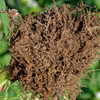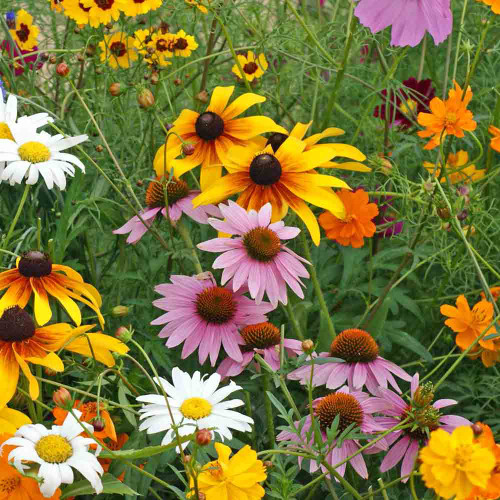Description
Soil Builder Seed Mix - Let Nature Create Healthy Soil for You
We've learned over the almost three decades we've been gardening that one of the best things we can do is to join Team Mother Nature—help get things started, then step out of the way and let her do the work as only she can. Our Soil Builder Mix is a powerful natural system of different soil specialists that know exactly how to build the rich, living soil your garden needs. By doing so, you activate nature's own processes to do the heavy lifting of soil renovation, creating the deep, foundational health that supports a thriving, resilient garden.
Your Garden’s Intensive Care System
Think of this mix as a powerful dose of intensive care for your garden, designed to restore its vitality from the ground up. We've learned that a healthy ecosystem is never a monoculture—an area planted with only a single species—which is why this isn't just a seed mix; it's a carefully selected community of 11 different plants. This "Soil Renovation Crew" is the solution we turn to for a significant rebuild, whether that's to replenish a bed after a season of hungry tomatoes and peppers or to build a competitive barrier against invasive weeds like Bermuda grass.
- The Nitrogen-Fixers (The Legumes): Mung Beans, Common Vetch, Crimson Clover, and Lentil act as the "fertilizer factories" of the mix. They pull nitrogen from the air and "fix" it in the soil, creating a free, plant-available source of fertility for your future crops.
- The Biomass-Builders (The Grasses): Millet, Spring Oats, Sorghum, and Spring Barley are the workhorses. They grow quickly to form a thick, protective mat that smothers weeds, prevents erosion, and adds a massive amount of valuable organic matter back into the soil.
- The Soil-Breakers & Specialists (The Broadleafs): Golden Flax, Phacelia, Safflower, and Sunflower are the deep-divers and specialists. Their powerful taproots break up compacted soil, while their flowers attract a host of beneficial insects and pollinators to your garden.
Together, this diverse community of plants sets the feasting table—a smorgasbord—for the beneficial life in your soil, attracting and feeding the microscopic allies that create a truly fertile garden.
Building a Thriving Community in Your Soil
Improving the soil's structure and nutrient content is only half the story. The real magic happens when the diverse root systems in this mix attract and support a thriving community of beneficial soil life, like mycorrhizal fungi. These microscopic allies act as a vast distribution network, delivering water and nutrients to your plants in a way that fertilizers alone never can. It's a fascinating win-win partnership that we explore in our article, "Why Grow Cover Crops."
What's in the Mix
A purposefully designed community of plants featuring a diverse team of soil-building specialists, including:
- Legumes (Nitrogen-Fixers): Mung Beans, Common Vetch, Crimson Clover
- Grasses (Biomass-Builders): Millet, Spring Oats, Sorghum, Spring Barley
- Broadleafs (Specialists): Golden Flax, Phacelia, Safflower, Sunflower
How to Plant and Use
Getting your Soil-Builder System started is simple and easy.
- Planting Rate: A little of this mix goes a long way. We recommend using 4 ounces of seed for approximately every 100-125 square feet of garden space (a 10x10 or 10x12 foot area). One pound of seed will generously cover a 400-500 square foot garden (a 20x20 or 20x25 foot area).
- Preparation: Simply prepare a clean seedbed by removing any existing weeds or crop residue and lightly raking the surface of the soil.
- Sowing: Broadcast the seed evenly across the prepared area. There's no need for perfect rows; the goal is to create a dense, living blanket. Gently rake the seed into the top half-inch of soil to ensure good seed-to-soil contact.
- Watering: Water the area regularly, keeping it consistently moist until the seeds have germinated and the young plants are established.
When to Terminate the Cover Crop
The timing for cutting down your cover crop depends on your goals. For a quick "recharge," you can cut it down any time after about 30 days of growth.
For maximum benefit, the ideal time to terminate the crop is after the first flowers have bloomed but before they set seed. This is a crucial step that prevents the cover crop from self-sowing and competing with your next season's vegetables. To terminate the crop, simply cut the plants down at the soil level, leaving the residue on the surface as a nutrient-rich mulch. For larger areas, a mower or a string trimmer is effective. For raised beds or smaller gardens, garden shears or even a sharp hoe will work perfectly.
- For Our Cool-Winter Gardeners: In colder zones, a hard killing frost will typically terminate the cover crop for you. We recommend monitoring the bed after the first few hard freezes to ensure the plants have been fully winter-killed.
- For Our Warm-Winter Gardeners: In warmer zones where the mix may survive the winter, you will need to terminate it mechanically after the first flowers appear to prepare for your next planting.
If you don't use the entire mix in one season, there's no need to worry. The seeds will remain viable for next season; simply store the remainder in a cool, dry place.
Learn More
- Cover Crops - Better Soil in a Month
- Why Grow Cover Crops: Easy Soil Improvement
- Cover Crops Beat Garden Weeds
- Cover Crops FAQ
- Which Cover Crop is Best for Me?
From the soil to the seed to the food you eat - we'll help you grow your best garden!
2 Reviews
-
Soil Builder
Great germination, fast early growth and very thick. Really looking forward to better soil.
-
Soil Builder Seed Mix (Cover Crop)
I love this! It is growing so healthy and lush. I love the great variety of plants in it. It will get turned in as a green manure day after tomorrow and I am so looking forward to reaping the benefits!























